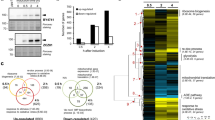Abstract
Mitogen activated protein kinases (MAPK) pathways play a key role in orchestrating the eukaryotic cellular response to different stimuli. In this process, phosphorylation of both conserved threonine and tyrosine residues of MAPKs is essential for their activation. Identification of tyrosine and dual specificity protein phosphatases capable of dephosphorylating these phosphosites is thus critical to gain insight into their regulation. Due to the conservation of pivotal elements in eukaryotic signaling, yeast has turned into a valuable tool to increase the knowledge of MAPK signaling in other cell types. Here we describe an in vivo method to evaluate the capacity of a protein, from yeast or other origin, to act as a MAPK phosphatase. It relies on the ability of the phosphatase to reduce, when overexpressed, both the amount of activated MAPK and the transcription from a specific promoter regulated by the corresponding pathway. To this end, the pathway has to be previously activated, preferentially through overexpression of a hyperactive allele of an upstream component within the MAPK module. Additionally, the ability of an overexpressed “trapping” inactive phosphatase version to modify these readouts is also analyzed. Western blotting analysis with specific anti-phospho MAPK antibodies and flow cytometry-based determination of fluorescence produced by GFP whose expression is driven by MAPK-regulated promoters are the selected techniques for monitoring these readouts.
Access this chapter
Tax calculation will be finalised at checkout
Purchases are for personal use only
Similar content being viewed by others
References
Chi A, Huttenhower C, Geer LY et al (2007) Analysis of phosphorylation sites on proteins from Saccharomyces cerevisiae by electron transfer dissociation (ETD) mass spectrometry. Proc Natl Acad Sci U S A 104:2193–2198
Hunter T, Plowman GD (1997) The protein kinases of budding yeast: six score and more. Trends Biochem Sci 22:18–22
Martin H, Flandez M, Nombela C et al (2005) Protein phosphatases in MAPK signalling: we keep learning from yeast. Mol Microbiol 58:6–16
Tonks NK, Neel BG (2001) Combinatorial control of the specificity of protein tyrosine phosphatases. Curr Opin Cell Biol 13:182–195
Caunt CJ, Keyse SM (2013) Dual-specificity MAP kinase phosphatases (MKPs): shaping the outcome of MAP kinase signalling. FEBS J 280:489–504
Engelberg D, Perlman R, Levitzki A (2014) Transmembrane signaling in Saccharomyces cerevisiae as a model for signaling in metazoans: state of the art after 25 years. Cell Signal 26:2865–2878
Roberts CJ, Nelson B, Marton MJ et al (2000) Signaling and circuitry of multiple MAPK pathways revealed by a matrix of global gene expression profiles. Science 287:873–880
Garcia R, Bermejo C, Grau C et al (2004) The global transcriptional response to transient cell wall damage in Saccharomyces cerevisiae and its regulation by the cell integrity signaling pathway. J Biol Chem 279:15183–15195
Posas F, Chambers JR, Heyman JA et al (2000) The transcriptional response of yeast to saline stress. J Biol Chem 275:17249–17255
Sacristan-Reviriego A, Martin H, Molina M (2015) Identification of putative negative regulators of yeast signaling through a screening for protein phosphatases acting on cell wall integrity and mating MAPK pathways. Fungal Genet Biol 77:1–11
Rispail N, Soanes DM, Ant C et al (2009) Comparative genomics of MAP kinase and calcium-calcineurin signalling components in plant and human pathogenic fungi. Fungal Genet Biol 46:287–298
Qi M, Elion EA (2005) MAP kinase pathways. J Cell Sci 118:3569–3572
Tonks NK, Neel BG (1996) From form to function: signaling by protein tyrosine phosphatases. Cell 87:365–368
Blanchetot C, Chagnon M, Dubé N et al (2005) Substrate-trapping techniques in the identification of cellular PTP targets. Methods 35:44–53
Sacristan-Reviriego A, Madrid M, Cansado J et al (2014) A conserved non-canonical docking mechanism regulates the binding of dual specificity phosphatases to cell integrity mitogen-activated protein kinases (MAPKs) in budding and fission yeasts. PLoS One 9:e85390
Mitchell DA, Marshall TK, Deschenes RJ (1993) Vectors for the inducible overexpression of glutathione S-transferase fusion proteins in yeast. Yeast 9:715–722
Martin H, Shales M, Fernandez-Pinar P et al (2015) Differential genetic interactions of yeast stress response MAPK pathways. Mol Syst Biol 11:800
Sikorski RS, Hieter P (1989) A system of shuttle vectors and yeast host strains designed for efficient manipulation of DNA in Saccharomyces cerevisiae. Genetics 122:19–27
Watanabe Y, Irie K, Matsumoto K (1995) Yeast RLM1 encodes a serum response factor-like protein that may function downstream of the Mpk1 (Slt2) mitogen-activated protein kinase pathway. Mol Cell Biol 15:5740–5749
Irie K, Gotoh Y, Yashar BM et al (1994) Stimulatory effects of yeast and mammalian 14-3-3 proteins on the Raf protein kinase. Science 265:1716–1719
Stevenson BJ, Rhodes N, Errede B et al (1992) Constitutive mutants of the protein kinase STE11 activate the yeast pheromone response pathway in the absence of the G protein. Genes Dev 6:1293–1304
Wurgler-Murphy SM, Maeda T, Witten EA et al (1997) Regulation of the Saccharomyces cerevisiae HOG1 mitogen-activated protein kinase by the PTP2 and PTP3 protein tyrosine phosphatases. Mol Cell Biol 17:1289–1297
Acknowledgements
We acknowledge the Centro de Citometría y Microscopía de Fluorescencia (UCM, Madrid, Spain) for flow cytometry analysis. This work was made possible thanks to grant BIO2013-44112-P from Ministerio de Economía y Competitividad, (Spain) and S2011/BMD-2414 from Comunidad Autónoma de Madrid (Spain). A.S-R is a recipient of a FPU fellowship from Ministerio de Educación y Ciencia (Spain).
Author information
Authors and Affiliations
Corresponding author
Editor information
Editors and Affiliations
Rights and permissions
Copyright information
© 2016 Springer Science+Business Media New York
About this protocol
Cite this protocol
Sacristán-Reviriego, A., Molina, M., Martín, H. (2016). Methods to Study Protein Tyrosine Phosphatases Acting on Yeast MAPKs. In: Pulido, R. (eds) Protein Tyrosine Phosphatases. Methods in Molecular Biology, vol 1447. Humana Press, New York, NY. https://doi.org/10.1007/978-1-4939-3746-2_21
Download citation
DOI: https://doi.org/10.1007/978-1-4939-3746-2_21
Published:
Publisher Name: Humana Press, New York, NY
Print ISBN: 978-1-4939-3744-8
Online ISBN: 978-1-4939-3746-2
eBook Packages: Springer Protocols




